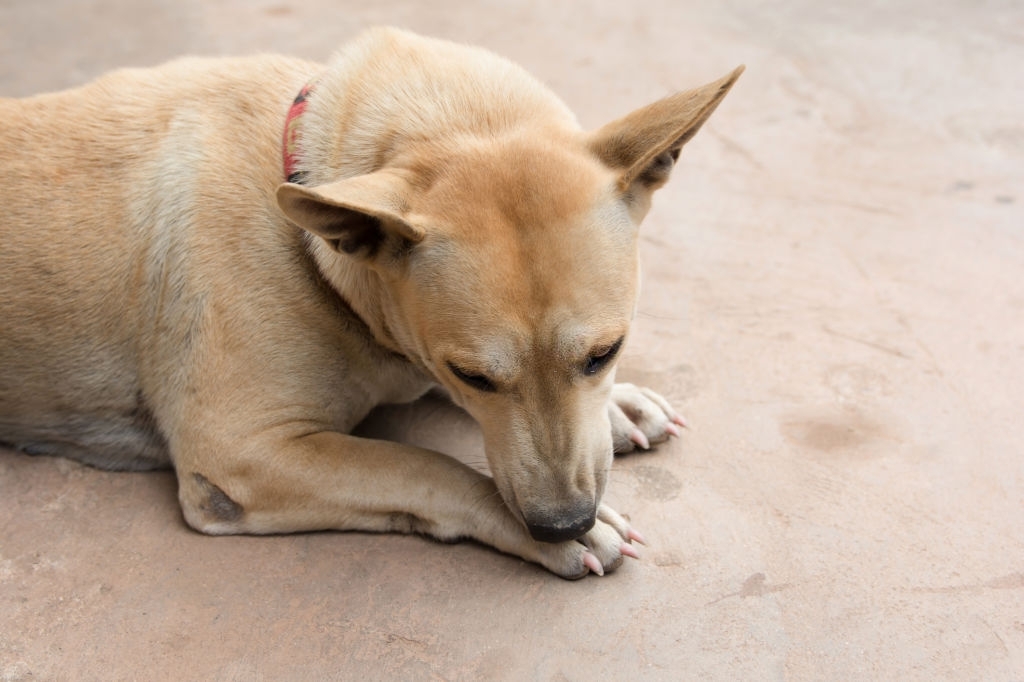Canine psychodermatoses or psychological dermatoses result in dermatological lesions, generally associated with a profound behavioral disorder caused by anxiety . This article considers these various clinical manifestations, mainly due to a stressful and anxiety-inducing environment .
Psychodermatoses in dogs, what are they?
These dermatoses of psychic origin have been studied in humans before being studied in dogs. The researchers became interested in this canine phenomenon, when they realized that a particular clinical entity, lick dermatitis , could be a model of obsessive-compulsive disorder (or OCD) in humans. Other clinical entities have been added over time to form what is called ” canine psychodermatoses “.
The role of anxiety in canine psychodermatoses
Environmental factors such as stress, the change of season, a conflictual situation that the dog can not resolve, boredom… thus plunge the animal into a state of anxiety, of which these psychological disorders become a clinical sign . Studies have correlated the fact that certain canine psychodermatoses, and in particular the licking sore, strongly coincided with forms of obsessive-compulsive disorder (OCD) in men. Anxiety is therefore the major cause of psychodermatoses.
Anxiety is defined as a characterized reaction state; a succession of triggering emotional reactions similar to those of fear, in response to any variation in the internal and external environment. This results in a disorganization of the self-controls and therefore a loss of adaptability to any variation in the environment .
Licking dermatitis
Licking is the cause of local alopecia with the formation of an erythema . When it becomes chronic, alopecia spreads with hypermelanization and lichenification of the skin. When fibrosis appears and the lesion becomes firm and raised, it is called a lick granuloma .
Bacterial infections do not often appear on the surface of the lesion because licking keeps the lesion “clean”. On the other hand, pus can indeed develop in fistulas or under the scabs. The presence of local lymphadenopathy is rarely noticed, however, in very advanced cases the licking may be the cause of a periosteal reaction, arthritis or ankylosis of the underlying joint. Over time, these licking disorders intensify, causing the lesions to evolve.
Spinning with tail mutilation
The animal turns in a circle on itself, the nose glued to the base of its tail. Sometimes the dog grabs it and bites it violently. This activity is often associated with growling, aggression, as well as frantic barking. It sometimes happens that the dog stops in its course, takes a position and stabilizes for a while.
We classify dizzy spells in the psychodermatoses of self-trauma . First, there is partial and then total alopecia of the dog’s tail . Then, an area of hyperpigmented induration appears. The animal can bite its tail very violently, which can lead to serious wounds.
Onychophagia
The dog bites its fingers , especially the thumbs, and bites its claws. In addition, the mutilations are sometimes very important . The animal can amputate its phalanges and, as a result, limp.
The lesion of the pacifiers
The dog frequently catches and sucks only one of its pacifiers. This grows, ignites and the skin lichenifies. This problem mainly affects females but it can also be found in males. Castration could nevertheless stop this habit .
Are there natural treatments to fight canine psychodermatosis?
Action on anxiety of Hawthorn:
- Sedative and anxiolytic action, reduction of aggressiveness, agitation, nervousness, excessive sensitivity to stress.
- Calms the anxiety of apprehension and anticipation, as well as reaction anxiety with cardiovascular manifestations.
Sedative and hypnotic action on the central nervous system of lemon balm :
- Chronic administration of lemon balm reduces anxiety-like behavior, improves circadian and exploratory activities.
Anxiolytic property of Rhodiola :
- Rhodiola has an effective anxiolytic activity.
Antidepressant and anxiolytic properties of St. John ‘s Wort :
- Non-specific inhibition of monoamine reuptake (mainly serotonin, but also dopamine and norepinephrine). This inhibition is not competitive, unlike what is observed for synthetic antidepressants such as fluoxetine. This results in an increase in the activity of serotonin.
- Repeated administration of H. perforatum induces an anxiolytic and anti-panic effect, and exerts an anti-stress effect in the defensive mode.
Anti-stress action Wamine serenity (plant complex):
- Wamine Serenity contributes to the management of stress and nervous states in dogs and cats. This pet food supplement is formulated with plants known for their soothing action.
Medical bibliographic sources and clinical trials :
- Young, M.S., Manning, T.O.- Psychogenic dermatosis (dog and cat).- Dermatology Reports, 1984
- Luescher, U.A., McKEOWN, D.B., HALIP, J.- Stereotypic or obsessive compulsive disorders in dogs and cats.- Veterinary clinics of North America :,Small Animal Practice.,March 1991
- Prelaud, P., Carlotti, D.N.- Dermatoses psychogènes.- Encyclopédie vétérinaire, Paris, 1992, Dermatologie
- Scott, M.J., Dermatophagia : « wolf-biter ».- Cutis, January 1997
- Scott, Miller, Griffin.- Muller and Kirk’s small animal dermatology.- 5e ed.- Philadelphia : W.B. Saunders Compagny, 1995.- chap. 14 :Psychogenic skin diseases
- Pageat, P.- Pathologies du comportement chez les carnivores domestiques.- 1e ed.- Maison-Alfort, Editions du Point Vétérinaire, 1995
- Hart, B.L., Powell, K.L.- Antibacterial properties of saliva : role in maternal periparturient grooming and in licking wounds.- Physiology and Behavior, 1990
- Pemberton, P.L.- Canine and feline behavior control : progestin therapy.- IN : KIRK, R.W.- Current Veterinary Therapy, 8e ed, Philadelphia, W.B. Saunders Co, 1983
- Beaver, B.- Animal behavior case of the month.- Journal of the American Veterinary Medical Association, June 1995
- Dodman, N.H., Bronson, R., Gliatto, J.- Tail chasing in a bull terrier.- Journal of the American Veterinary Medical Association.,March 1, 1993
- Reisner, I.- The pathophysiologic basis of behavior problems.- Veterinary Clinics of North America : Small Animal Practice, March 1991
- Soulimani R. et al., Neurotropic action of the hydroalcoholic extract of Melissa officinalis in the mouse, Planta Medica., 1991
- Ibarra A. et al., Effects of chronic administration of Melissa officinalis L. extract on anxiety-like reactivity and on circadian and exploratory activities in mice, Phytomedicine, 2010
- Perfumi M. et al., Adaprogenic and central nervous system effects of single doses of 3% rosavin and 1% salidroside Rhodiola rosea L. extract in mice, Phytother Res, 2007
- Flausino O.A. Jr, Zangrossi H. Jr, Salgado J.V. et al., Effects of acute and chronic treatment with Hypericum perforatum L. (LI 160) on different anxiety-related responses in rats, Pharmacol Biochem in rats, Pharmacol Biochem Behav., 2002
- Beijamini V., Andreatini R., Effects of Hypericum perforatum and paroxetine on rat performance in the elevated T-maze, Pharmacol Res., 2003





